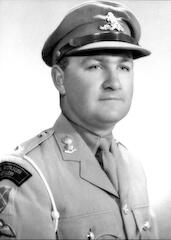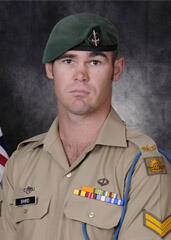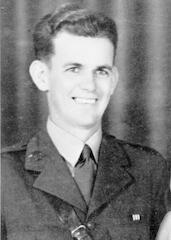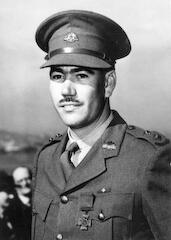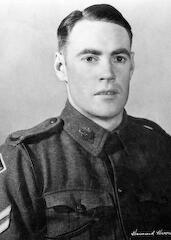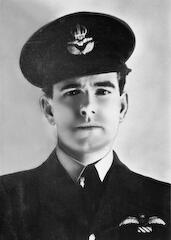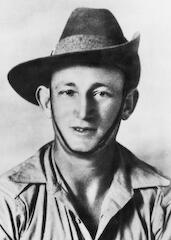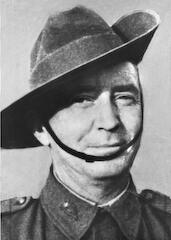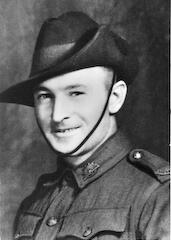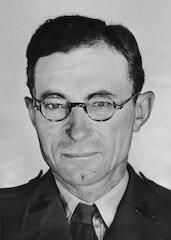
Victoria Cross recipients A–G
Charles Anderson VC
NX 12595 Lieutenant Colonel Charles Groves Wright ANDERSON MC
2/19th Australian Infantry Battalion, A.I.F.
18th to 22nd January 1942 in Malaya
Charles Groves Wright ANDERSON was born in Cape Town, South Africa on 12 February 1897. After his war service he served as Federal member for Hume during the period 1949 to 1951 and 1955 to 1961. He died on 11 November 1988.
"During operations in Malaya from 18th to 22nd January, 1942, Lieutenant-Colonel Anderson, in command of a small force, was sent to restore a vital position and to assist a Brigade. His force destroyed ten enemy tanks. When later cut off, he defeated persistent attacks on his position from air and ground forces and forced his way through the enemy line to a depth of fifteen miles."
"He was again surrounded and subjected to very heavy, frequent attacks, resulting in severe casualties to his force. He personally led an attack with great gallantry on the enemy, who were holding a bridge, and succeeded in destroying four guns. Lieutenant-Colonel Anderson, throughout all this fighting, protected his wounded and refused to leave them. He obtained news by wireless of the enemy position and attempted to fight his way back through eight miles of enemy occupied country. This proved to be impossible, and the enemy were holding too strong a position for any attempt to be made to relieve him. On 19th January, Lieutenant-Colonel Anderson was ordered to destroy his equipment and make his way as best he could around the enemy position."
"Throughout the fighting, which lasted for four days, he set a magnificent example of brave leadership, determination and outstanding courage. He not only showed fighting qualities of very high order but throughout exposed himself to danger without any regard for his own personal safety."
London Gazette: 13th February 1942.
[Photo courtesy of the Australian War Memorial]
Peter Badcoe VC
41400 Major Peter John BADCOE
Australian Army Training Team Vietnam
23 February to 7 April 1967
Thua Thien Province, South Vietnam
Peter John BADCOE was born in Adelaide on 11 January 1934. He was buried at the Terendak Cemetery, Malaysia.
"On 23 February, in Phu Thu District, Major Badcoe with complete disregard for his own safety moved alone across 600 metres of fire swept ground and reached a United States Medical Adviser wounded by enemy fire, attended to him and ensured his future safety. He then organised a force of one platoon and led them towards the enemy post. His personal leadership, words of encouragement, and actions in the face of hostile enemy fire, forced the platoon to successfully assault the enemy position and capture it.
"On 7th March 1967, in Quang Dien District, Major Badcoe led a company in an attack over open terrain to assault and capture a heavily defended enemy position. In the face of certain death and heavy losses his personal courage and leadership turned certain defeat into victory and prevented the enemy from capturing District Headquarters.
"On 7th April 1967, in Huong Tra District, Major Badcoe was with a South Vietnamese company which came under heavy small arms fire and withdrew to a cemetery for cover. This left Major Badcoe and his radio operator about 50 metres in front of the leading elements, under heavy mortar fire. Seeing this withdrawal, Major Badcoe ran back to them, moved amongst them and by encouragement and example got them moving forward again. He then set out in front of the company to lead them on and when getting up to throw a grenade he was hit and killed by a burst of machine gun fire.
"Major Badcoe's conspicuous gallantry and leadership on all these occasions was an inspiration to all, each action, ultimately, was successful, due entirely to his efforts, the final one ending in his death. His valour and leadership were in the best traditions of the military profession and the Australian Regular Army".
London Gazette: 13 October 1967; Supplement, 17 October 1967.
[Photo courtesy of the Australian War Memorial]
Cameron Baird, VC, MG
Awarded the Victoria Cross for Australia
Corporal Cameron Stewart Baird, MG
13th February 2014, Uruzgan province, Afghanistan
"For the most conspicuous acts of valour, extreme devotion to duty and ultimate self-sacrifice at Ghawchak village, Uruzgan province, Afghanistan, as a Commando Team Commander in Special Operations Task Group on Operation SLIPPER.
"Corporal Cameron Baird enlisted in the Australian Regular Army in 2000, was discharged in2004, and re-enlisted in 2006. In both periods of service, he was assigned to the 4th Battalion (Commando), Royal Australian Regiment. His operational service includes Operations TANAGER, FALCONER, BASTILLE and four tours on Operation SLIPPER. He was awarded the Medal for Gallantry for his service in Afghanistan in 2007–08.
"On 22 June 2013, a commando platoon of the Special Operations Task Group, with partners from the Afghan National Security Forces, conducted a helicopter assault into Ghawchak village, Uruzgan province, in order to attack an insurgent network deep within enemy-held territory. Shortly after insertion, Corporal Baird’s team was engaged by small arms fire from several enemy positions. Corporal Baird quickly seized the initiative, leading his team to neutralise the positions, killing six enemy combatants and enabling the assault to continue.
"Soon afterwards, an adjacent Special Operations Task Group team came under heavy enemy fire, resulting in its commander being seriously wounded. Without hesitation, Corporal Baird led his team to provide support. En route, he and his team were engaged by rifle and machine gun fire from prepared enemy positions. With complete disregard for his own safety, Corporal Baird charged towards the enemy positions, supported by his team. On nearing the positions, he and his team were engaged by additional enemy on their flank. Instinctively, Corporal Baird neutralised the new threat with grenades and rifle fire, enabling his team to close with the prepared position.
"With the prepared position now isolated, Corporal Baird manoeuvred and was engaged by enemy
machine-gun fire, the bullets striking the ground around him. Displaying great valour, he drew the fire, moved to cover, and suppressed the enemy machine gun position. This action enabled his team to close on the entrance to the prepared position, thus regaining the initiative.
"On three separate occasions Corporal Baird charged an enemy-held building within the prepared compound.
"On the first occasion he charged the door to the building, followed by another team member. Despite being totally exposed and immediately engaged by enemy fire, Corporal Baird pushed forward while firing into the building. Now in the closest proximity to the enemy, he was forced to withdraw when his rifle ceased to function. On rectifying his rifle stoppage, and reallocating remaining ammunition within his team, Corporal Baird again advanced towards the door of the building, once more under heavy fire. He engaged the enemy through the door but was unable to suppress the position and took cover to reload.
"For a third time, Corporal Baird selflessly drew enemy fire away from his team and assaulted the doorway. Enemy fire was seen to strike the ground and compound walls around Corporal Baird, before visibility was obscured by dust and smoke.
"In this third attempt, the enemy was neutralised and the advantage was regained, but Corporal Baird was killed in the effort.
"Corporal Baird’s acts of valour and self-sacrifice regained the initiative and preserved the lives of his team members. His actions were of the highest order and in keeping with the finest traditions of the Australian Army and the Australian Defence Force."
Albert Chowne VC
NX24405 Lieutenant Albert CHOWNE MM
2/2nd Australian Infantry Battalion, AIF
25th March, 1945, near Dagua, New Guinea
Albert CHOWNE was born in Sydney, 19th July, 1920. He is buried at the Lae War Cemetery, New Guinea.
"For most conspicuous bravery, brilliant leadership and devotion to duty during an attack on an enemy position on a narrow ridge near Dagua, New Guinea, on 25th March, 1945. After the capture of Dagua, the main enemy force withdrew southwards from the beach to previously prepared positions on the flank of the Division. Further movement towards Wewak was impossible while this threat to the flank existed and the Battalion was ordered to destroy the enemy force."
"A" Company, after making contact with the enemy on a narrow ridge, was ordered to attack the position. The leading Platoon in the attack came under heavy fire from concealed enemy machine-guns sited on a small rise dominating the approach. In the initial approach one member of this Platoon was killed and nine wounded, including the Platoon Commander, and the enemy continued to inflict casualties on our troops."
"Without awaiting orders, Lieutenant Chowne, whose Platoon was in reserve, instantly appreciated the plight of the leading Platoon and rushed the enemy's position. Running up a steep, narrow track, he hurled grenades which knocked out two enemy Light Machine-Guns. Then, calling on his men to follow him, and firing his sub-machine gun from the hip, he charged the enemy's position."
"Although he sustained two serious wounds in the chest, the impetus of his charge carried him 50 yards forward under the most intense machine-gun and rifle fire. Lieutenant Chowne accounted for two more Japanese soldiers before he was killed standing over three foxholes occupied by the enemy."
"The superb heroism and self-sacrifice of this officer culminating in his death, resulted in the capture of this strongly-held enemy position, ensured the further immediate success of his Company in this area and paved the way directly for the continuance of the Division's advance to Wewak."
London Gazette: 6th September, 1945.
[Photo courtesy of the Australian War Memorial]
Roden Cutler VC
NX12378 Lieutenant Arthur Roden CUTLER
2/5th Australian Field Regiment
19th June to 6th July 1941, at Merdjayoun-Damour area, Syria
Lieutenant Arthur Roden CUTLER was born at Manly, New South Wales on 24 May 1916. Sir Roden Cutler VC, AK, KCMG, KCVO, CBE served as Governor of New South Wales from 1966 to 1981. He died on 21 February 2002 and was buried in the South Head Cemetery, Sydney, New South Wales.
"For most conspicuous and sustained gallantry during the Syrian campaign and for outstanding bravery during the bitter fighting at Merdjayoun when this artillery officer became a byword amongst forward troops with which he worked."
"At Merdjayoun on 19 June 1941, our infantry attack was checked."
"Enemy machine gun fire swept the ground but Lieutenant Cutler with another artillery officer and a small party pushed on ahead of the infantry and established an outpost in a house."
"The enemy then attacked this outpost with infantry and tanks, killing the Bren gunner and mortally wounding other officers. Lieutenant Cutler and another manned the anti- tank rifle and Bren gun and fought back, driving the enemy infantry away."
Lieutenant Cutler then personally supervised the evacuation of the wounded members of his party"
"With a small party of volunteers he pressed on until finally with one other he succeeded in establishing an outpost right in the town"
"At this time Lieutenant Cutler knew the enemy were massing on his left for a counter attack and that he was in danger of being cut off. Nevertheless he carried out his task of registering the battery on the road and engaging enemy posts"
"His work in registering the only road by which enemy transport could enter the town was of vital importance and a big factor in the enemy's subsequent retreat."
"On the night of 23rd-24th June he was in charge of a 25-pounder sent forward into our forward defended localities to silence an enemy anti-tank gun and post, which had held up our attack."
"This he did and next morning the capture of Medjayoun was completed. Later at Damour on 6th July, when our forward infantry was pinned to the ground by heavy hostile machine gun fire Lieutenant Cutler, regardless of all danger, went to bring a line to his outpost when he was seriously wounded. Twenty six hours elapsed before it was possible to rescue this officer, whose wounds by this time had become septic necessitating the amputation of his leg."
"Throughout the Campaign this officer's courage was unparalleled and his work was a big factor in the recapture of Medjayoun."
London Gazette 28th November 1941.
[Photo courtesy of the Australian War Memorial]
Thomas Derrick VC
SX 7964 Sergeant Thomas Currie DERRICK DCM
2/48th Australian Infantry Battalion. A.I.F.
24th November 1943, at Sattleburg, New Guinea
Thomas Currie DERRICK was born in Medindie, Adelaide on 20 March 1914. He was commissioned as a Lieutenant on the 26th November 1944. He was killed in action on Tarakan Island on 24 May 1945 and is buried in the Tarakan War Cemetery.
"On 24th November 1943 a company of an Australian infantry battalion was ordered to outflank a strong enemy position sited on a precipitous cliff-face and then to attack a feature 150 yards from the township of Sattelberg. Sergeant Derrick was a platoon commander in this company. Over a period of two hours many attempts were made by our troops to clamber up the slopes to their objective, but on each occasion the enemy prevented success with intense machine gun fire and grenades."
"It appeared it would be impossible to reach the objective and the company was ordered to retire. On receipt of this order, Sergeant Derrick requested one last attempt to reach the objective. His request was granted. Moving ahead of his forward section he personally destroyed with grenades an enemy post which had been holding up his section. He then ordered his second section around on the right flank."
"This section came under heavy fire from light machine guns and grenades from six enemy posts. Without regard for personal safety he clambered forward well ahead of the leading men of the section and hurled grenade after grenade, so completely demoralising the enemy that they fled leaving weapons and grenades."
"By this action alone the company was able to gain its first foothold on the precipitous ground. Not content with the work already done he returned to the first section, and together with the third section of his platoon advanced to deal with three of the remaining posts in the area."
"On four separate occasions he dashed forward and threw grenades at a range of six to eight yards until these posts were finally silenced."
"In all, Sergeant Derrick had reduced ten enemy posts. From vital ground he had captured, the remainder of the Battalion moved on to capture Sattelberg the following morning."
"Undoubtedly Sergeant Derrick's fine leadership and refusal to admit defeat in the face of a seemingly impossible situation resulted in the capture of Sattelberg. His outstanding gallantry, thoroughness and devotion to duty were an inspiration not only to his platoon and company but to the whole battalion."
London Gazette: 23rd March 1944.
[Photo courtesy of the Australian War Memorial]
Mark Donaldson VC
Trooper Mark Gregor Strang DONALDSON
Special Air Service Regiment
2nd September 2008 at Oruzgan Province, Afghanistan
For most conspicuous acts of gallantry in action in a circumstance of great peril in Afghanistan as part of the Special Operations Task Group during Operation SLIPPER, Uruzgan province, Afghanistan.
"Trooper Mark Gregor Strang Donaldson enlisted into the Australian Army on 18 June 2002. After completing recruit and initial employment training, he was posted to the 1st Battalion, Royal Australian Regiment. Having successfully completed the Special Air Service selection course in April 2004, Trooper Donaldson was posted to Special Air Service Regiment in May 2004.
"On 2 September 2008, during the conduct of a fighting patrol, Trooper Donaldson was travelling in a combined Afghan, US and Australian vehicle convoy that was engaged by a numerically superior, entrenched and coordinated enemy ambush. The ambush was initiated by a high volume of sustained machine-gun fire coupled with the effective use of rocket-propelled grenades. Such was the effect of the initiation that the combined patrol suffered numerous casualties, completely lost the initiative and became immediately suppressed. It was over two hours before the convoy was able to establish a clean break and move to an area free of enemy fire.
"In the early stages of the ambush, Trooper Donaldson reacted spontaneously to regain the initiative. He moved rapidly between alternate positions of cover engaging the enemy with 66mm and 84mm anti-armour weapons as well as his M4 rifle. During an early stage of the enemy ambush, he deliberately exposed himself to enemy fire in order to draw attention to himself and thus away from wounded soldiers. This selfless act alone bought enough time for those wounded to be moved to relative safety.
"As the enemy had employed the tactic of a rolling ambush, the patrol was forced to conduct numerous vehicle manoeuvres, under intense enemy fire, over a distance of approximately 4km to extract the convoy from the engagement area. Compounding the extraction was the fact that casualties had consumed all available space within the vehicles. Those who had not been wounded, including Trooper Donaldson, were left with no option but to run beside the vehicles throughout. During the conduct of this vehicle manoeuvre to extract the convoy from the engagement area, a severely wounded coalition force interpreter was inadvertently left behind. Of his own volition and displaying complete disregard for his own safety, Trooper Donaldson moved alone, on foot, across approximately 80 metres of exposed ground to recover the wounded interpreter. His movement, once identified by the enemy, drew intense and accurate machine-gun fire from entrenched positions. Upon reaching the wounded coalition force interpreter, Trooper Donaldson picked him up and carried him back to the relative safety of the vehicles, then provided immediate first aid before returning to the fight.
"On subsequent occasions during the battle, Trooper Donaldson administered medical care to other wounded soldiers, while continually engaging the enemy.
"Trooper Donaldson’s acts of exceptional gallantry in the face of accurate and sustained enemy fire ultimately saved the life of a coalition force interpreter and ensured the safety of the other members of the combined Afghan, US and Australian force. Trooper Donaldson’s actions on this day displayed exceptional courage in circumstances of great peril. His actions are of the highest accord and are in keeping with the finest traditions of Special Operations Command, the Australian Army and the Australian Defence Force."
Commonwealth of Australia Gazette No. S 10 of 2009 dated 20 January 2009.
[Photo courtesy of the Department of Veterans Affairs]
John Edmondson VC
NX15705 Corporal John Hurst EDMONDSON
2/17th Australian Infantry Battalion AIF
13th April 1941 at Tobruk, Libya
John Hurst EDMONDSON was born at Wagga Wagga, New South Wales on 8th October, 1914. He is buried in the Tobruk War Cemetery, Libya.
"On the night of 13th-14th April 1941, a party of German infantry broke through the wire defences at Tobruk and established themselves with at least six machine guns, mortars and two small field pieces. It was decided to attack them with bayonets, and a party consisting of one officer, Corporal Edmondson and five privates, took part in the charge."
"During the counter-attack Corporal Edmondson was wounded in the neck and stomach, but continued to advance under heavy fire, killing one enemy with his bayonet. Later his officer had his bayonet in one of the enemy and was grasped about the legs by him, when another attacked him from behind."
"He called for help, and Corporal Edmondson, who was some yards away, immediately came to his assistance and in spite of his wounds, killed both of the enemy. This action undoubtedly saved his officer's life."
"Shortly after returning from this successful counter-attack, Corporal Edmondson died of wounds. His actions throughout the operations were outstanding for resolution, leadership and conspicuous bravery."
London Gazette: 4th July, 1941.
[Photo courtesy of the Australian War Memorial].
Hughie Edwards VC
39005 Acting Wing Commander Hughie Idwal EDWARDS DFC
No. 105 Squadron, Royal Air Force
4th July 1941, in raid on Bremen, Germany
"Hughie EDWARDS was born at Fremantle, Western Australia, on 1 August 1914. He died in Sydney on 5 August 1982 and was buried in the Northern Suburbs Cemetery, Sydney, New South Wales.
"Wing Commander Edwards, although handicapped by a physical disability resulting from a flying accident, repeatedly displayed gallantry of the highest order in pressing home bombing attacks from very low heights against strongly defended objectives.
"On 4th July, 1941, he led an important attack on the port of Bremen, one of the most heavily defended towns in Germany His attack had to be made in daylight and there were no clouds to afford concealment. During the approach to the German coast several enemy ships were sighted and Wing Commander Edwards knew that his aircraft would be reported and that the defences would be in a state of readiness.
"Undaunted by this misfortune he brought his formation 50 miles overland to the target, flying at a height of little more than 50 feet, passing under high-tension cables, carrying away telegraph wires, and finally passing through a formidable balloon barrage.
"On reaching Bremen he was met with a hail of fire, all aircraft were hit and four destroyed. Nevertheless he led a most successful attack, and then with the greatest skill and coolness withdrew the surviving aircraft without further loss.
"Throughout the execution of this operation, which he had planned personally with full knowledge of the risks entailed, Wing Commander Edwards displayed the highest possible standard of gallantry and determination."
London Gazette: 22nd July 1941.
[Photo courtesy of the Australian War Memorial]
John French VC
QX 1071 Corporal John Alexander FRENCH
2/9th Australian Infantry Battalion, AIF
4th September 1942, at Milne Bay, New Guinea
John Alexander FRENCH was born in Crow's Nest, 28 miles north of Toowoomba (Queensland) on 15th July 1914. He is buried in the Port Moresby (Bomana) War Cemetery, Papua.
"At Milne Bay on the afternoon of the 4th September, 1942, a company of an Australian infantry battalion attacked the Japanese position East of the K.B. Mission where it encountered terrific rifle and machine gun fire. The advance of the section of which Corporal French was in command was held up by fire from three enemy machine gun posts, whereupon, Corporal French, ordering his section to take cover, advanced and silenced one of the posts with grenades."
"He returned to his section for more grenades and again advanced and silenced the second post. Armed with a Thompson sub-machine gun, he then attacked the third post, firing from the hip as he went forward. He was seen to be badly hit by the fire from this post, but he continued to advance."
"The enemy gun then ceased to fire and his section pushed on to find that all members of the three enemy gun crews had been killed and that Corporal French had died in front of the third gun pit."
"By his cool courage and disregard of his own personal safety, this non-commissioned officer saved the members of his section from heavy casualties and was responsible for the successful conclusion of the attack."
London Gazette: 14th January, 1943.
[Photo courtesy of the Australian War Memorial]
James Gordon VC
WX 2437 Private James Heather GORDON
2/31st Australian Infantry Battalion, A.I.F.
10th July 1941, near Jezzine Djezzinel, Syria
James Heather GORDON was born at Rockingham, Western Australia on 7 March 1909. He died on 19 July 1986 and was buried in the Karrakatta Cemetery, Perth, Western Australia.
"On the night of 10th July 1941 during an attack on "Greenhill", North of Djezzine, Private Gordon's Company came under intense machine-gun fire and its advance was held up. Movement even by single individuals became impossible, one officer and two men being killed and two men being wounded in the effort to advance. The enemy machine-gun position which had brought the two forward platoons to a halt was fortified and completely covered the area occupied by our forces."
"Private Gordon, on his own initiative, crept forward over an area swept by machine-gun and grenade fire and succeeded in approaching close to the post; he then charged it from the front and killed the four machine-gunners with bayonet."
"His action completely demoralised the enemy in this sector and the Company advanced and took the position. During the remainder of the action that night and on the following day, Private Gordon, who has throughout operations shown a high degree of courage, fought with equal gallantry."
London Gazette: 28th October 1941.
[Photo courtesy of the Australian War Memorial].
Percival Gratwick VC
WX 10426 Private Percival Eric GRATWICK
2/48th Australian Infantry Battalion, AIF
Night 25th-26th October 1942, at Miteiriya Ridge, Egypt
Percival GRATWICK was born on 19th October, 1902 at Katanning (Western Australia). He is buried in the War Cemetery at El Alamein.
"During the attack on Trig 29 at Miteiriya. Ridge on the night of 25th-26th October, 1942, the Company to which Private Gratwick belonged, met with severe opposition from strong enemy positions which delayed capture of the Company's objective and caused a considerable number of casualties."
"Private Gratwick's Platoon was directed at these strong positions but its advance was stopped by intense enemy fire at short range. Withering fire of all kinds killed the platoon commander, the platoon sergeant and many other ranks and reduced the total strength of the Platoon to seven."
"Private Gratwick grasped the seriousness of the situation and acting on his own initiative, with utter disregard for his own safety at a time when the remainder of the Platoon were pinned down, charged the nearest post and completely destroyed the enemy with hand grenades, killing amongst others a complete mortar crew."
"As soon as this task was completed, and again under heavy machine-gun fire, he charged the second post with rifle and bayonet. It was from this post that the heaviest fire had been directed."
"He inflicted further casualties, and was within striking distance of his objective, when he was killed by a burst of machine-gun fire."
"By his brave and determined action, which completely unnerved the enemy, and by his successful reduction of the enemy's strength, Private Gratwick's Company was able to move forward and mop up its objective."
"Private Gratwick's unselfish courage, his gallant and determined efforts against the heaviest opposition, changed a doubtful situation into the successful capture of his Company's final objective."
London Gazette: 28th January, 1943.
[Photo courtesy of the Australian War Memorial]
Arthur Gurney VC
WX9858 Private Arthur Stanley GURNEY
2/48th Australian Infantry Battalion AIF
22nd July 1942 at Tel el Eisa, Egypt
Arthur Stanley GURNEY was born at Day Dawn, on the Murchison Goldfields of Western Australia on 15th December, 1908. He is buried in the El Alamein War Cemetery, Egypt.
"For gallantry and unselfish bravery in silencing enemy machine-gun posts by bayonet assault at Tel el Eisa on 22nd July 1942, thus allowing his Company to continue the advance. During an attack on a strong German position in the early morning of 22nd July 1942, the Company to which Private Gurney belonged, was held up by intense machine-gun fire from posts less than 100 yards ahead, heavy casualties being inflicted on our troops, all the officers being killed or wounded."
"Grasping the seriousness of the situation and without hesitation, Private Gurney charged the nearest enemy machine-gun post, bayoneted three men and silenced the post. He then continued on to a second post, bayoneted two men and sent out a third as a prisoner."
"At this stage a stick of grenades was thrown at Private Gurney which knocked him to the ground. He rose again, picked up his rifle and charged the third post using the bayonet with great vigour. He then disappeared from view and later his body was found in an enemy post."
"By this single-handed act of gallantry in the face of a determined enemy, Private Gurney enabled his Company to press forward to its objective, inflicting heavy losses on the enemy. The successful outcome of this engagement was almost entirely due to Private Gurney's heroism at the moment when it was needed."
London Gazette: 11th September 1942.
[Photo courtesy of the Australian War Memorial]

